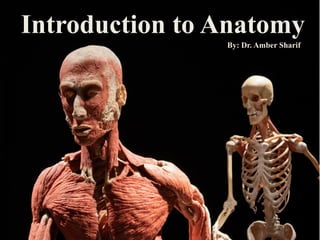intro to anatomy.pdf
•
2 j'aime•45 vues
basic introduction to human anatomy
Signaler
Partager
Signaler
Partager
Télécharger pour lire hors ligne

Recommandé
Recommandé
Contenu connexe
Similaire à intro to anatomy.pdf
Similaire à intro to anatomy.pdf (20)
INTRODUCTION OF HUMAN BODY (ANATOMY & PHYSIOLOGY).pptx

INTRODUCTION OF HUMAN BODY (ANATOMY & PHYSIOLOGY).pptx
Dernier
Dernier (20)
GUIDELINES ON SIMILAR BIOLOGICS Regulatory Requirements for Marketing Authori...

GUIDELINES ON SIMILAR BIOLOGICS Regulatory Requirements for Marketing Authori...
Hire 💕 9907093804 Hooghly Call Girls Service Call Girls Agency

Hire 💕 9907093804 Hooghly Call Girls Service Call Girls Agency
Vip profile Call Girls In Lonavala 9748763073 For Genuine Sex Service At Just...

Vip profile Call Girls In Lonavala 9748763073 For Genuine Sex Service At Just...
Formation of low mass protostars and their circumstellar disks

Formation of low mass protostars and their circumstellar disks
Discovery of an Accretion Streamer and a Slow Wide-angle Outflow around FUOri...

Discovery of an Accretion Streamer and a Slow Wide-angle Outflow around FUOri...
Seismic Method Estimate velocity from seismic data.pptx

Seismic Method Estimate velocity from seismic data.pptx
Botany krishna series 2nd semester Only Mcq type questions

Botany krishna series 2nd semester Only Mcq type questions
Pests of mustard_Identification_Management_Dr.UPR.pdf

Pests of mustard_Identification_Management_Dr.UPR.pdf
Disentangling the origin of chemical differences using GHOST

Disentangling the origin of chemical differences using GHOST
Nightside clouds and disequilibrium chemistry on the hot Jupiter WASP-43b

Nightside clouds and disequilibrium chemistry on the hot Jupiter WASP-43b
intro to anatomy.pdf
- 1. Human Anatomy Introduction Introduction to Anatomy By: Dr. Amber Sharif
- 2. Session outcomes • By the end of the session students will be able to describe basic anatomical terms • By the end of the session students will be able to use these terms to describe normal movement
- 3. What is Anatomy? • Study of the STRUCTURE of the Human Body • Closely related to PHYSIOLOGY! • Physiology is the study of the FUNCTION of the human body
- 4. Divisions of Anatomy • Gross Anatomy • Structures that can be seen with the eye • Muscles, bones, various organs • Microscopic Anatomy • Structures that cannot be seen with the eye • Need to use a microscope • Cytology = study of cells • Histology = study of tissues
- 5. • Regional Anatomy – study one region of the body at a time and learn everything about the region • Systemic Anatomy – study one body system at a time. This is the approach we will use in this course
- 6. • In addition, Embryology is the study of the embryo and the fetus, that is, the study of prenatal development, whereas the study of congenital malformations is known as Teratology.
- 7. Anatomical Organization • Cells • Tissues • Organs • Organ Systems • Organism
- 8. Organ Systems 1. Integument 2. Skeletal 3. Muscular 4. Nervous 5. Endocrine 6. Cardiovascular 7. Lymphatic 8. Respiratory 9. Digestive 10. Urinary 11. Reproductive
- 9. Directional Terms • Superior : means the part is above another or closer to head (cranial ). Vs. • Inferior: means the part is below another or towards the feet (caudal).
- 10. • Anterior: means towards the front (the eyes are anterior to the brain) - [ventral]. Vs. • Posterior: means toward the back (the pharynx is posterior to the oral cavity) - [dorsal].
- 11. • Medial: relates to the imaginary midline dividing the body into equal right and left halves (the nose is medial to the eyes). Vs. • Lateral: means towards the side with respect to the imaginary midline (the ears are lateral to the eyes).
- 14. • Ipsilateral: the same side (the spleen and descending colon are ipsilateral ). Vs. • Contralateral: Refers to the opposite side (the spleen and gallbladder are contralateral ).
- 15. • Proximal : is used to describe a part that is closer to the trunk of the body or closer to another specified point of reference than another part (the elbow is proximal to the wrist). Vs. • Distal: it means that a particular body part is farther from the trunk or farther from another specified point of reference than another part (fingers are distal to the wrist).
- 16. • Superficial: means situated near the surface. Peripheral also means outward or near the surface. Vs. • Deep: is used to describe parts that are more internal .
- 18. Regional Terms • Axial part : includes the head, neck, and trunk. • Appendicular part : Includes the limbs which are attached to the body's axis.
- 19. 19
- 21. Terms to describe movements Occurring at Various Joints 1. Flexion : Flexion is the movement where similar surfaces come nearer to each other reducing the angle between them. ex: Bending of fore arm near elbow 2. Extension: It is the movement causing similar surfaces to go apart. It is opposite to flexion. ex : Straightening of bent fore arm.
- 22. 3. Adduction: It is the movement bringing the limb towards mid line. 4. Abduction: It is the movement taking the limb away from the mid line. 5. Rotation: It is the movement around central axis involving 360 6. Medial rotation : It is rotation towards medial direction
- 23. 7. Lateral rotation: Rotation towards lateral direction is called lateral direction 8. Circumduction: It is the movement involving flexion, abduction, extension and adduction occurring in sequence